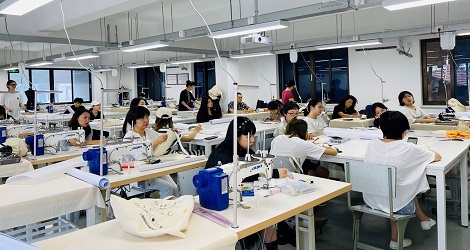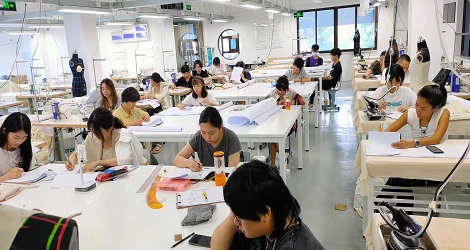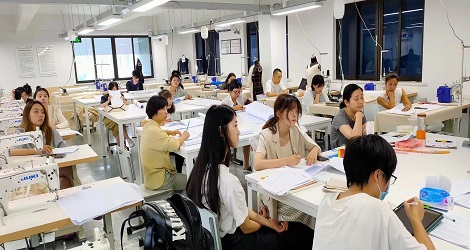【Course Introduction】
Pattern making is a key component of modern fashion engineering, which comprises three parts: styling design, structural design, and process design. As the structural design part, pattern making bridges creative styling and process design. Fashion design includes: 1) creative design (style sketches expressing silhouette, fabric, and color); 2) structural design (also known as pattern making with precise measurements for each part); 3) process design (the sewing procedure of a finished garment). Among these, pattern making plays a pivotal role. It requires precision in style, dimensions, and detail, and completeness in outer, lining, interfacing, and process patterns. Since sketches alone cannot fully represent a garment’s 3D form or allow functional testing, a sample prototype must be developed before mass production to ensure fit, comfort, and aesthetics.
【Enrollment Target】
Beginners with no prior experience who aim to become professional pattern makers.
Designers and professionals working in the fashion and garment industry.
【Course Content】
1.Flat (Manual) Pattern Making
Learn the fundamentals of garment sizing systems, body measurements, fabric estimation, and technical specifications across a range of styles. Women's wear includes skirts, trousers, tops, blouses, dart manipulation and transfer, suits, dresses, Qipao, coats, business attire, and casualwear. Men's wear covers shirts, vests, trousers, suits, and overcoats. The course also introduces basic grading, pattern scaling, and fabric consumption calculations, tailored specifically for beginners with no prior experience.
2.Draping (3D Pattern Making)
Introduction to the fundamentals of draping: tools, materials, guideline marking, and the use of pins. Basic draping techniques include pleating, waving, twisting, gathering, weaving, and combined methods. Garment draping covers: bodice draping techniques for front and back prototypes; skirt draping methods and dart manipulation for design variations; collar and sleeve draping; draping of classic styles such as dresses and evening gowns; and pattern development for bridal wear and structured undergarments (corsetry).
3.Apparel Design
This module covers the foundations of apparel design, including basic hand stitching, machine sewing techniques, and pressing fundamentals. For skirts, students will learn waistband attachment, installation of exposed and concealed zippers, plackets, and pleat construction. Trouser-making techniques include waistband sewing, interfacing plackets, assembling back seams, sewing front and back welt pockets, zipper insertion, and final pressing. Shirt construction covers interfacing front plackets, pressing darts, collar and sleeve assembly, sleeve seam finishing, buttonhole stitching, and button attachment. Women's blazer design includes pattern layout and fabric estimation, cutting and marking of main and auxiliary fabrics, fusing interfacings and tape pressing, easing and assembling garment panels, and techniques for sewing pocket flaps, collars, sleeves, linings, shoulder pad insertion, and full garment pressing.
4. Fashion CAD:
Pattern-making Management System: Introduction to the digital pattern-making interface, including mouse and keyboard functions; file management, editing, and viewing; parameter settings and unit preferences. Learn to define attributes for pattern pieces, lines, notches, and points. Point operations include identifying point symbols on patterns or lines, adding notches, reference points, intersection points, duplicating, editing, and deleting points. Notch and line handling includes scaling notches, creating straight or curved lines, right angles, and replacing or deleting line segments. Pattern piece operations include creating and editing patterns, adding pleats and rotations (such as knife pleats and bust darts), designing seam allowances and angles, resizing, splitting, and merging pattern pieces. Grading and layout operations include pattern grading, marker creation, setting up production files, layout rules, generating marker plans, and fabric yield optimization. (A basic understanding of cutting is required for this course.)
【Introduction of Teachers】
Dean of SIFEC Fashion School, Associate Professor, Head of the Fashion Teaching and Research Office, Member of SIFEC Academic Committee, Member of the Shanghai Garment Trade Association, Member of the China and Shanghai Color Association, and Expert Advisor for the Shanghai Labor Bureau. Honored as a Shanghai Model Worker.
Senior Visiting Lecturer at SIFEC Fashion School, with 20 years of industry experience. Actively involved in corporate management and has personally designed and tailored high-profile garments for public appearances by prominent figures. Deeply engaged with market trends and committed to staying at the forefront of fashion. Certified National Vocational Qualification Assessor and Technical Director at Roche Tailoring Company.









